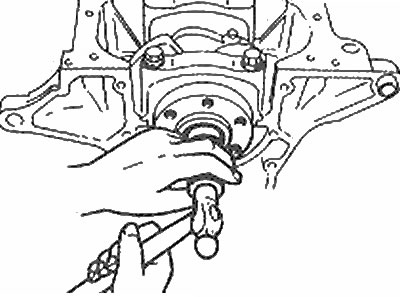2. Install the motor head up.
3. Remove the main bearing cap bolts and lift the caps up. Put them in the correct order and check that they are installed correctly.
4. If they are in place, remove the old bearing shells from the block and main bearing cap. Wipe the main bearing surfaces of the block and caps with a clean cotton cloth. They must be kept spotlessly clean.
5. Clean the backs of the new main bearing shells and lay the halves into the main bearing housings on the block. Make sure the key on the bearing shell fits into the notch on the block or cover. Also make sure that the lubrication holes in the block line up with the lubrication holes in the bearing shell. At this time, no lubricant is used.

Install the gearbox input shaft bearing into the crankshaft (models with manual transmission)
6. Thrust bearing must be installed on #3 seat.
7. Clean the bearing surfaces in the block and the crankshaft main bearing journals with a clean cotton cloth. Check and clean the oil holes in the crankshaft.
8. If you are sure that the crankshaft is clean, carefully place it in the main bearings.
9. Before the crankshaft is finally installed, check the operating clearance of the main bearing.
10. Install Plastigage (tool for measuring clearances in plain bearings) on each root neck, parallel to its axis.
11. Clean the surfaces of the bearing shells in the caps and install the caps on their respective connecting rods (don't mix them up), so that the arrows printed on them point towards the front of the engine. Do not move Plastigage.
12. Starting at the center main bearing and working towards the ends of the crankshaft, tighten the main bearing cap bolts in three steps to the specified torque. Do not rotate the crankshaft during this operation.
13. Turn off bolts and accurately remove covers of radical bearings. Do not mix Plastigage and do not rotate the crankshaft. If any of the covers are difficult to remove, gently tap them with a mallet.
14. Compare the width of the Plastigage with the scale shown on the tool box to calculate the operating clearance of the main bearings. Compare the value obtained with the data given in Specifications.
15. If the clearance is not correct, check again that the correct size bushings are installed in the bearings. Also make sure that when measuring the gap between the shells and the surface of the main bearing, no dirt or oil has entered.
16. Carefully clean all traces of Plastigage from the journals and/or bearing shell surfaces. Do not damage surfaces.
17. Carefully lift the crankshaft off the engine. Clean the bearing surfaces of the bearings in the block, then apply a thin, even coat of high quality clean molybdenum grease or special motor assembly oil to each of the bearing faces.
18. Make sure the crankshaft journals are clean, then install the crankshaft. O Clean the thrust surfaces of the bearings in the caps, then apply a thin, uniform coat of clean molybdenum grease to them. Install the covers in the appropriate positions so that the arrows on them point towards the front of the engine. Install the bolts and tighten them with a torque specified specifications, starting at the center main bearing and working towards the ends of the crankshaft.
19. On manual transmission models, install a new gearbox input shaft bearing into the end of the crankshaft. Lubricate the crankshaft recess and outer circumference of the bearing with clean engine oil, and install the bearing. Gently drive it into place with a mallet, using a piece of tubing of a suitable size. Lubricate the inner surface of the bearing.
20. Turn the crankshaft several times by hand to make sure it turns freely.
21. Finally, check the crankshaft end play with a micrometer as described in Chapter 12.
